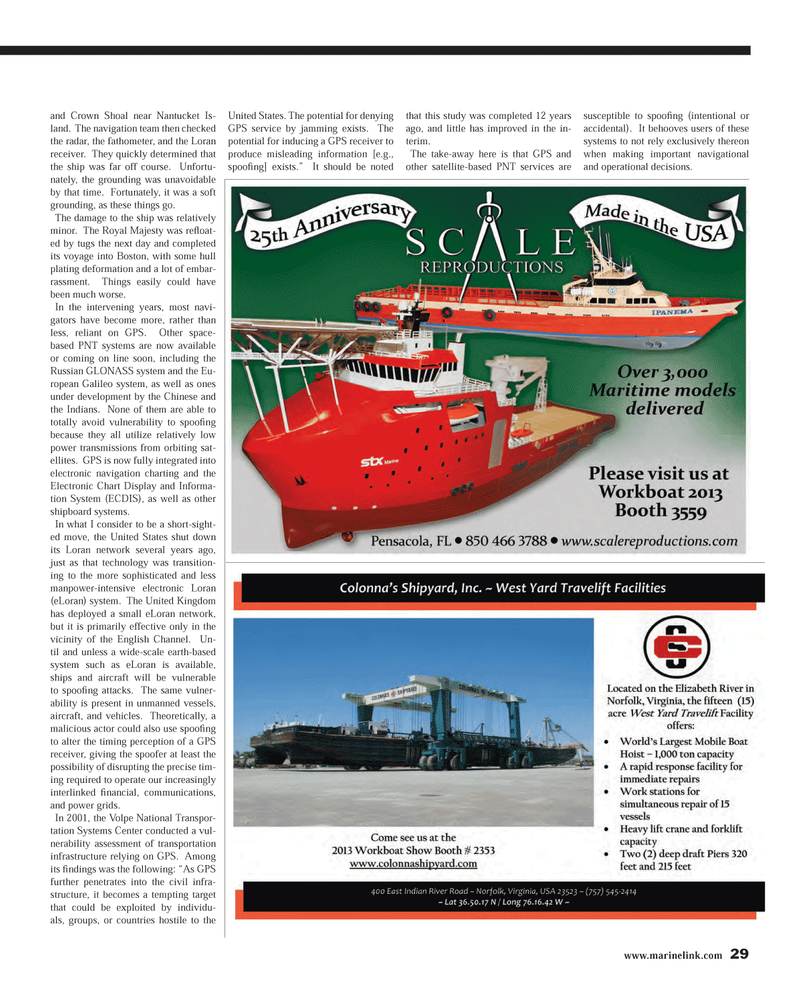
Page 29: of Maritime Reporter Magazine (September 2013)
Workboat Annual
Read this page in Pdf, Flash or Html5 edition of September 2013 Maritime Reporter Magazine
www.marinelink.com 29and Crown Shoal near Nantucket Is-land. The navigation team then checked the radar, the fathometer, and the Loran receiver. They quickly determined that the ship was far off course. Unfortu- nately, the grounding was unavoidable by that time. Fortunately, it was a soft grounding, as these things go. The damage to the ship was relatively minor. The Royal Majesty was re ß oat-ed by tugs the next day and completed its voyage into Boston, with some hull plating deformation and a lot of embar- rassment. Things easily could have been much worse.In the intervening years, most navi-gators have become more, rather than less, reliant on GPS. Other space-based PNT systems are now available or coming on line soon, including the Russian GLONASS system and the Eu-ropean Galileo system, as well as ones under development by the Chinese and the Indians. None of them are able to totally avoid vulnerability to spooÞ ng because they all utilize relatively low power transmissions from orbiting sat-ellites. GPS is now fully integrated into electronic navigation charting and the Electronic Chart Display and Informa-tion System (ECDIS), as well as other shipboard systems.In what I consider to be a short-sight-ed move, the United States shut down its Loran network several years ago, just as that technology was transition-ing to the more sophisticated and less manpower-intensive electronic Loran (eLoran) system. The United Kingdom has deployed a small eLoran network, but it is primarily effective only in the vicinity of the English Channel. Un-til and unless a wide-scale earth-based system such as eLoran is available, ships and aircraft will be vulnerable to spooÞ ng attacks. The same vulner- ability is present in unmanned vessels, aircraft, and vehicles. Theoretically, a malicious actor could also use spooÞ ng to alter the timing perception of a GPS receiver, giving the spoofer at least the possibility of disrupting the precise tim-ing required to operate our increasingly interlinked Þ nancial, communications, and power grids. In 2001, the Volpe National Transpor- tation Systems Center conducted a vul-nerability assessment of transportation infrastructure relying on GPS. Among its Þ ndings was the following: ?As GPS further penetrates into the civil infra-structure, it becomes a tempting target that could be exploited by individu-als, groups, or countries hostile to the United States. The potential for denying GPS service by jamming exists. The potential for inducing a GPS receiver to produce misleading information [e.g., spooÞ ng] exists.? It should be noted that this study was completed 12 years ago, and little has improved in the in-terim.The take-away here is that GPS and other satellite-based PNT services are susceptible to spooÞ ng (intentional or accidental). It behooves users of these systems to not rely exclusively thereon when making important navigational and operational decisions.MR #9 (26-33).indd 29MR #9 (26-33).indd 299/3/2013 10:13:03 AM9/3/2013 10:13:03 AM

 28
28

 30
30
